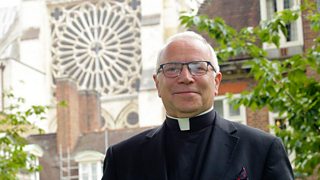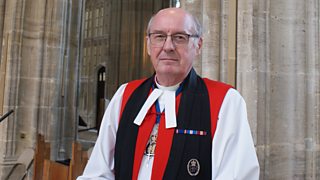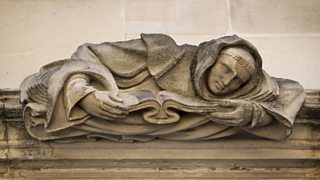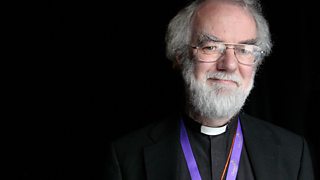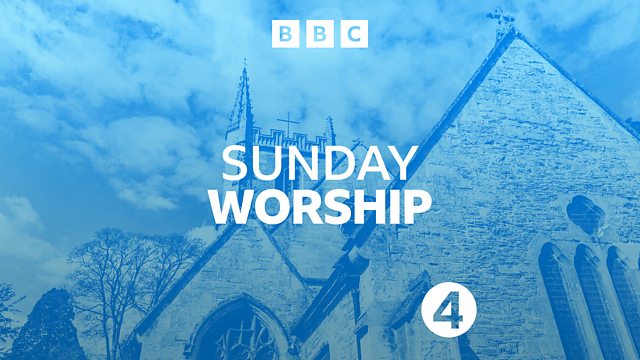
Stories of Salvation
In a service from Christ Church, Oxford, Canon Angela Tilby and Canon Edmund Newell explore Christian themes in Grimm's Fairy Tales, on the 200th anniversary of their publication.
In a service from Christ Church Cathedral Oxford, Canon Angela Tilby and Canon Edmund Newell explore Christian themes of innocence, temptation and the reward of virtue in Grimm's Fairy Tales during a year of celebrations marking the 200th anniversary of their publication. Director of Music: Clive Driskill-Smith. Producer: Stephen Shipley.
Last on
More episodes
Previous
Christ Church, Oxford 12/05/13
Please
note:
This script cannot exactly reflect the transmission, as it was prepared before
the service was broadcast. It may include editorial notes prepared by the
producer, and minor spelling and other errors that were corrected before the
radio broadcast.
It may contain gaps to be filled in at the time so that prayers may reflect the
needs of the world, and changes may also be made at the last minute for timing
reasons, or to reflect current events.
��
Radio 4 Opening Announcement:�� ����ý Radio 4.�� It’s ten past eight and time to go live to Oxford for today’s Sunday Worship.�� It’s led by Canon Angela Tilby.
��
ANGELA TILBY:
Good morning and welcome to Oxford’s Cathedral at Christ Church. The theme of our worship this Sunday in Ascensiontide is Stories of Salvation and it’s focused on those haunting and sometimes terrifying tales of the Brothers Grimm. The first edition of Grimm’s Children’s and Household Tales was published in December 1812 – and so the 200th anniversary celebrations have been taking place this year.
��
Stories play an important part in the Christian faith. ��The Bible is full of stories; the story of Jesus has inspired Christians for 2,000 years. With me this morning is the Rev Dr Edmund Newell, Principal of Cumberland Lodge. ��Later he will be drawing parallels between Christian themes from the Bible and the stories we know so well – of Hansel and Gretel, Snow White, and Cinderella. These all have a message about good and evil and the final triumph of those who trust in goodness.
��
We begin our worship as the Choir of Christ Church Cathedral leads us in the Ascensiontide hymn: ‘Christ is the King, O friends rejoice.’
��
CHOIR AND CONGREGATION:�� HYMN - CHRIST IS THE KING CP 165
��
ANGELA TILBY: ��PRAYER
‘Christ through all ages is the same:
Place the same hope in his great name’
��
So we give thanks to the risen and ascended Lord.
��
Glory to you Lord, for your triumph over evil and sin;
for your mercy to our human race,
for the strength you have given to all who suffer
and the light you are to all who seek.
Fill us now with your Holy Spirit
that we may trust you with the whole of ourselves,
and come to love above all else
the name which is above every name,
Jesus Christ our Lord. Amen.
��
ANGELA TILBY:
Fairy tales are not as simple as they appear and they are not only for children. The great psychologist Bruno Bettelheim said that most Western fairy tales have at some time had a Christian dimension. That was certainly the case of the versions by the Brothers Grimm. Their main editor, Wilhelm Grimm, wanted them to be a guide to the young, to help them to find the presence of God through the trials of every day life.
��
CHOIR: HANDEL - LORD I TRUST THEE
��
ANGELA TILBY:
One much loved tale by the Brothers Grimm is that of Hansel and Gretel. It’s a chilling tale, set in the time of a famine, in which brother and sister Hansel and Gretel are left to die in a forest by their starving stepmother and father. Lost and bewildered, things are getting desperate, when they see and follow a beautiful white bird, a dove. Jeany Spark reads for us what happens next. And then Edmund Newell will comment on it.
��
JEANY SPARK: The bird sang so delightfully that they stood still and listened to it. And when it had finished its song, it spread its wings and flew away before them. They followed it until they reached a little house, where it landed on the roof. And when they got close to the little house they saw that it was made of bread and covered with cakes, and that the windows were clear sugar. "We will set to work on that," said Hansel, "and have a good meal. I will eat a bit of the roof, and you, Gretel, can eat some of the window, it will taste sweet." Hansel reached up, and broke off a piece of the roof to see how it tasted, and Gretel leant against the window and nibbled at the panes. Then a soft voice cried from inside:"Nibble, nibble, gnaw,
��Who is nibbling at my little house?"
[The children replied,
��"The wind, the wind,
��The heaven-born wind,"
and went on eating without disturbing themselves. Hansel, who thought the roof tasted very nice, tore down a great piece of it, and Gretel pushed out the whole of one round window-pane, sat down, and ate it. Suddenly the door opened, and a very, very old woman, on crutches, came creeping out. Hansel and Gretel were so frightened that they dropped what they had in their hands. The old woman, however, nodded her head, and said, "Oh, you dear children, who has brought you here? Do come in, and stay with me. No harm shall come to you."]
EDMUND NEWELL:[Harm, of course, was very much on the witch’s mind.]
��
Most of us are familiar with fairy tales. They were probably told to us as children, and we too may have told them to our children or grandchildren. As an adult, I’ve enjoyed rediscovering them. As a priest, I find them fascinating and helpful.
��
I find them fascinating because I can see all sorts of parallels and illusions to Bible stories. I find them helpful because they’re teaching me about the art of storytelling, so I can read some parts of Scripture in a new light - Jesus’ parables, for example.
��
We’ve just heard an extract from ‘Hansel and Gretel’, when the starving children are led by a white bird to the witch’s cottage. One theme that seems to run through the Grimm’s fairy tales is the guidance of the Holy Spirit. In this story, the dove is almost certainly Wilhelm Grimm’s representation of the Holy Spirit. Why should the Holy Spirit lead the children to a witch who wants to eat them? Well, it’s their encounter with evil that proves to be their salvation. Hansel and Gretel’s resilience is tested, and in overcoming the witch they learn important lessons and grow in maturity – enabling their safe journey home. In the way the Brothers Grimm tell this ancient story, it becomes an allegory about spiritual growth and God’s guidance.
��
The idea of the Holy Spirit guiding a starving person through a remote place to confront evil is thoroughly Biblical. According to Matthew’s Gospel, before he began his public ministry Jesus faced a similar test:
��
READER (CHOIR MAN):
Then Jesus was led up by the Spirit into the wilderness to be tempted by the devil. He fasted forty days and forty nights, and afterwards he was famished. The tempter came and said to him, ‘If you are the Son of God, command these stones to become loaves of bread. But he answered, ‘It is written, “One does not live by bread alone, but by every word that comes from the mouth of God.’
(Matthew 4:1-4)
��
��
EDMUND NEWELL:
There’s a strong sense that by being tested in this way, Jesus is equipped for the challenges his ministry would bring. We, too, can find spiritual strength through the trials and tribulations we face.
��
ANGELA TILBY: ��PRAYER
Almighty God,
whose Son Jesus Christ fasted forty days in the wilderness,
and was tempted as we are, yet without sin;
give us grace to discipline ourselves in obedience to your Spirit;
and, as you know our weakness,
so may we know your power to save;
through Jesus Christ your Son our Lord.�� Amen.
��
CHOIR: TIPPETT – STEAL AWAY����
��
ANGELA TILBY:
Michael Tippett’s setting of the spiritual, ‘Steal Away’. The second of Grimm’s stories we shall look at this morning is that of Snow White.
�� JEANY SPARK: “Mirror, Mirror, on the wall,Who in this land is the fairest of all?"
The mirror answered:
��"Queen, you are fairer than all who are
here."
��But more beautiful still is Snow White."
Then the Queen was shocked, and turned yellow and green with envy. From that hour, whenever she looked at Snow White, her heart heaved in her breast, she hated the girl so much.
And envy and pride grew higher and higher in her heart like a weed, so that she had no peace day or night. She called a huntsman, and said, "Take the child away into the forest; I will no longer have her in my sight. Kill her, and to prove it bring me back her liver and lungs."
EDMUND NEWELL:Dark, menacing and secluded, forests are obvious places for dastardly deeds. They’re also disorientating: places to get lost in, and full of hidden dangers. On the edge of civilisation, forests play an important role in many fairy tales as places of testing and discovery, as we’ve already heard in Hansel and Gretel.
��
Cumberland Lodge, the education centre where I live and work, is in the heart of Windsor Great Park. We’re surrounded by trees, including medieval woodland that’s often used as a film set. It’s easy to see why – it’s an eerie place that stirs the imagination, especially at dusk.
��
We’ve just heard how the jealous Queen sent Snow White into the forest to be killed. Of course, the huntsman spares her, and Snow White survives and finds refuge in the forest in the little house of the seven dwarfs. With another echo of Jesus’ three-fold temptation in the wilderness, Snow White is tempted three times by the devilish queen, who comes to the house when Snow White is alone, disguised first as a peddler woman, then as another old woman, and then, finally, as a farmer’s wife – bringing a tempting apple.
��
Like Eve in the Garden of Eden, the good girl Snow White can’t resist the apple and succumbs to temptation. She eats the poisoned apple, and dies.
A prince - the ‘king’s son’ - sees Snow White dead in a glass coffin, and asks the dwarfs for her body. As his servants carry her away, they trip and the piece of poisonous apple dislodges from her throat and she wakes. Her first words are, ‘Heaven’s! Where am I?’ Perhaps this is a rhetorical question, because, as the Grimm’s tell the story, the symbolism seems to be that of resurrection. Snow White is released from the grip of death by the king’s son – the Christ figure – who replies, ‘You are with me’. Snow White is with Christ, and they’re going, as the king’s son says, to ‘my father’s palace’ – to heaven.
��
There’s resonance here with Jesus’ comforting words to his disciples in John’s Gospel:
��
READER: (CHOIR MAN)
‘Do not let your hearts be troubled. Believe in God, believe also in me. In my Father’s house there are many dwelling places. If it were not so, would I have told you that I go to prepare a place for you? And if I go and prepare a place for you, I will come again and will take you to myself, so that where I am, you may be also.’
(John 14: 1-3)
��
EDMUND NEWELL:
There’s hopefulness and reassurance in Snow White; that our faithfulness to God will in the end be rewarded and that evil and death will not have the final say.
��
ANGELA TILBY: ��PRAYER
Lord of all life and power,
who through the mighty resurrection of your Son
overcame the old order of sin and death
to make all things new in him:
grant that we, being dead to sin
and alive to you in Jesus Christ,
may reign with him in glory.�� Amen
��
CHOIR: ��VAUGHAN WILLIAMS - COME MY WAY, MY TRUTH, MY LIFE
��
ANGELA TILBY:
Come my way, my truth, my life. Vaughan William’s setting of George Herbert’s poem. Probably the best known of the fairly tales of the Brothers Grimm is the one we know of as Cinderella. But the original is rather different from the one most of us are familiar with. There are no ugly sisters and no fairy godmother and Cinderella herself goes by her original German name: Ashputtel.
��
JEANY SPARK:
Ashputtel’s step-mother said, "All this won’t help you; you are not going with us. You have no clothes and you can’t dance; we’d be ashamed of you!" At this she turned her back on Ashputtel, and hurried away with her two proud daughters.
As no one was now at home, Ashputtel went to her mother's grave beneath the hazel-tree, and cried,
��"Shiver and quiver, little tree,
��Silver and gold throw down over me."
Then the bird threw a gold and silver dress down to her, and slippers embroidered with silk and silver. She put on the dress with all speed, and went to the feast.
[Her step-sisters and step-mother however did not know her, and thought she must be a foreign princess, for she looked so beautiful in the golden dress. They never once thought of Ashputtel, believing that she was sitting at home in the dirt, picking lentils out of the ashes. The prince went to meet her, took her by the hand and danced with her. He would dance with no other, and never let go of her hand, and if any one else asked he to dance, he said, "This is my partner."]
EDMUND NEWELL:
There’s something deeply moving about the Brothers Grimm’s version of Ashputtel. Instead of a fairy godmother, Ashputtel is helped to go to the royal feast by a bird that perches on the branch of a tree growing on her mother’s grave. Again, for the Brothers Grimm, this bird seems to represent the Holy Spirit.
��
In the Grimm’s version of this ancient story, Ashputtel’s stepsisters are beautiful, yet when the king’s son sees Ashputtel he sees her beauty. She’s radiant, wearing a dress given to her by the dove in the tree. It’s as if she’s clothed in the gifts of the Holy Spirit.
��
CHOIR: arr. WOOD - KING JESUS HATH A GARDEN
��
EDMUND NEWELL:
Of course, Ashputtel runs away from the feast, and the prince tries to find her. It’s ‘on the third day’ that the king’s son is reunited with the Ashputtel at her home. Despite being poor and filthy, living among the ashes in the kitchen, he takes her for his bride.
��
As the brothers Grimm tell the story, we’re confronted with two images of humanity. Ashputtel’s father, stepmother and stepsisters are materially well off, yet morally and spiritually bankrupt. Ashputtel, who’s poor and despised, is morally aware and spiritually open. It’s these that lead her into union with the king’s son – the Christ figure.
��
The story is pointing towards the teaching of Jesus; that those who appear to have everything are often spiritually empty, but the poor, the innocent, the gentle, the pure in heart are those who are truly blessed.
��
READER (CHORISTER):
When Jesus saw the crowds he went up the mountain: and after he sat down, his disciples came to him. Then he began to speak, and taught them saying:
��
‘Blessed are the poor in spirit, for theirs is the kingdom of heaven.
Blessed are those who mourn, for they shall be comforted.
Blessed are the meek, for they shall inherit the earth.
Blessed are those who hunger and thirst after righteousness, for they will be filled.
Blessed are the merciful, for they will receive mercy.
Blessed are the pure in heart for they will see God.
Blessed are the peacemakers for they will be called children
of God.
Blessed are those who are persecuted for righteousness sake for theirs is the
Kingdom of heaven.
(Matthew 5.1-8)
��
CHOIR: BLEST ARE THE PURE IN HEART - WALFORD DAVIES
��
EDMUND NEWELL:
As I’ve listened to these stories as told by the Brothers Grimm, it’s struck me how cruel some of them are and how disturbing, especially when you think they were in part intended for children. But then many of the stories in the Bible have cruel and disturbing elements, not least those told by Jesus. I can’t help thinking of the man at the wedding feast who is thrown out for not wearing a wedding garment; the unforgiving servant who nearly throttles the man who’s in debt to him, and all those goats who end up being banished from the presence of God at the last judgment.
��
I think that Bible stories often work in the same way as fairy tales – they exaggerate to make a point. This is very typical of the way storytelling works. You want things black and white, almost in caricature, so there are macabre and humorous elements that go into the story. In that way, they reach beyond the surface of the mind and touch the emotions. Grimm’s tales, like some Bible stories, seem to be addressed to a child’s world; but adults have all been children, and we all retain something of that primitive inner-world where our deepest hopes and fears lie – deeper than rationality.
��
ANGELA TILBY:
And so we pray.
��
We give thanks for tales that inspire,
for the ancient wisdom passed through them
from generation to generation.
We give thanks, too, for the gift of storytellers.
In this anniversary year of the Brothers Grimm,
we give thanks for their insights of faith,
that as we explore through their tales
our hopes and fears, our joys and sorrows,
we may be grounded more deeply
in faith and hope and love.
We ask this in the name of the king’s son,
Jesus Christ our Lord. Amen.
��
TOPICAL BIDDINGS TO BE ADDED
��
Our Father, who art in heaven,
hallowed be thy name;
thy kingdom come;
thy will be done;
on earth as it is in heaven.
Give us this day our daily bread.
And forgive us our trespasses,
as we forgive those who trespass against us.
And lead us not into temptation;
but deliver us from evil.
For thine is the kingdom,
the power and the glory,
for ever and ever. Amen.
��
And now to end our service John Bunyan’s pilgrim hymn ‘Who would true valour see’:
��
CHOIR AND CONGREGATION: HYMN – WHO WOULD TRUE VALOUR SEE CP621
��
ANGELA TILBY: ��BLESSING
��
Christ our King pour upon you the abundance of his gifts
and bring you to reign with him in glory;
and the blessing of God Almighty,
the Father, the Son and the Holy Spirit,
be among you and remain with you always. Amen.
��
��
ORGAN VOLUNTARY: BACH – PRELUDE IN E FLAT, BWV552
��
Broadcast
- Sun 12 May 2013 08:10����ý Radio 4


